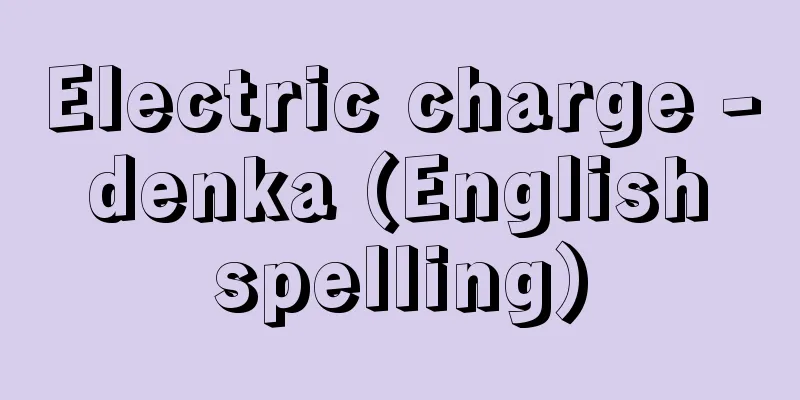Electric charge - denka (English spelling)

|
The substance that is the basis of electrical phenomena, and its quantity is called the electric charge. Sometimes the terms electric charge, electric quantity, or electricity are used interchangeably. Electric charge is classified into two types, positive and negative, and is called positive charge and negative charge, respectively. When equal amounts of positive and negative charges are combined, the result is a state of no charge, which is called electrically neutral. Conversely, when a positive charge is separated from a neutral state, an equal amount of negative charge always appears. This separation is what causes electricity to be generated by friction. A particle with an electric charge is called a charged particle, and a charged particle whose size can be ignored is called a point charge. In general, the law of conservation of charge holds that the algebraic sum of electric charges is constant in a closed system. An electric charge has the smallest atomic unit amount, and this unit amount is called the elementary charge or elementary charge, and is represented by the symbol e . Electric charge can ultimately be attributed to the charge of elementary particles, with the charge of an electron being -e and the charge of a proton being + e . All electric charges are integer multiples of the elementary charge, and microscopic particles such as atomic nuclei have an electric charge Ze . Z is an integer called the atomic number of this nucleus. The reason why macroscopic electric quantities appear to have any continuous value is because the elementary charge is an extremely small value of 1.6×10 -19 C. The existence of quarks, particles with a charge one-third the elementary charge, was hypothesized, but their existence was experimentally confirmed in 1994. Note that quarks only exist in elementary particles, so the smallest charge observed in nature is e . Source: Encyclopaedia Britannica Concise Encyclopedia About Encyclopaedia Britannica Concise Encyclopedia Information |
|
電気現象のもとになる実体で,その量を電気量という。電荷,電気量または電気を同じ意味に用いることもある。電荷を正,負の2種に分類し,それぞれ正電荷,負電荷などという。等量の正電荷と負電荷を合せると電荷のない状態となり,これを電気的に中性であるという。逆に,中性の状態から正電荷を分離すると必ず等量の負電荷が現れる。摩擦によって電気を生じるのは,このような分離による。電荷をもった粒子を荷電粒子,大きさを無視できる荷電粒子を点電荷という。一般に,閉じた系においては電荷の代数和は一定であるという電荷保存則が成り立つ。電気量は原子的な最小の単位量をもち,この単位量を電気素量あるいは素電荷と呼んで記号 e で表わす。電荷は究極的には素粒子の電荷に帰することができ,電子の電荷は -e ,陽子の電荷は +e である。すべての電荷は電気素量の整数倍であって,微視的な粒子たとえば原子核は電荷 Ze をもつ。 Z はこの原子核の原子番号と呼ばれる整数である。巨視的な電気量が連続的に任意の値をもつようにみえるのは,電気素量がきわめて小さい値 1.6×10-19C だからである。電気素量の 1/3 の電荷をもつ粒子クォークの存在が仮想されていたが,1994年にその存在が実験的に確証された。なお,クォークは素粒子の中でのみ存在するので自然界で観測される最小の電荷は e である。
出典 ブリタニカ国際大百科事典 小項目事典ブリタニカ国際大百科事典 小項目事典について 情報 |
>>: Your Highness - Electricity
Recommend
Imperative delegation
Also known as compulsory delegation, this system a...
Bombus diversus (English spelling) Bombus diversus
…[Setsuya Momoi]. . . *Some of the terminology th...
Daijo-in Temple and Shrine Notes - Daijo-in Temple and Shrine Notes
This is the diary of Jinson, the 19th head priest...
Mother fixation
…A term referring to excessive attachment or fixa...
Zikmunt
…King of Hungary (Zsigmond), reigned 1387-1437. K...
Verbena hybrida (English spelling) Verbenahybrida
… [Munemin Yanagi]. … *Some of the terminology th...
Kawai Tozaemon - Kawai Tozaemon
...It was called the Mankoku Sodo because it was ...
Rokukugi (English spelling) ṣat‐padārtha
Six principles advocated by the Vaisheshika school...
Crispus Caesar, Flavius Julius
[raw]? [Died] 326. Polana. Eldest son of the Roman...
Detonator - Kibakuyaku
An explosive that decomposes easily and reaches i...
Association (English spelling)
Daly stated that there are two types of igneous ro...
Kananbare - Kananbare
...The dolls used in the Hinamatsuri festival are...
Legal act - Houritsu koui
A legal act is an act that a person performs with...
Musa nana (English spelling) Musanana
… [Akira Takahashi]. … *Some of the terminology t...
Mr. Oyama
A powerful clan in Shimotsuke in the Middle Ages....









